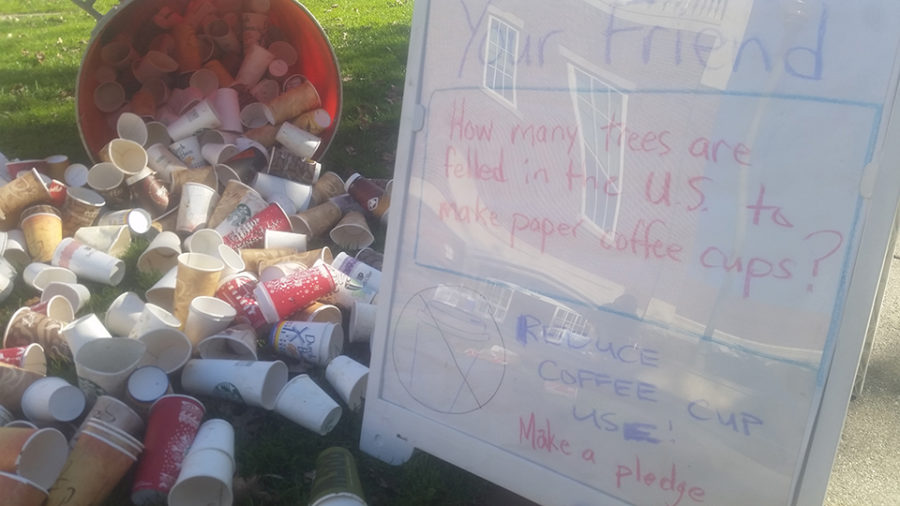Fear, hope and optimism.
Those are the three emotions that drove a group of Santa Rosa Junior College students, staff and faculty members to develop a proposal addressing an undeniable environmental crisis: global warming.
As one of the largest community colleges in Northern California, enrolling more than 26,000 students per semester, staff members acknowledged the importance and significance of educating and becoming role models for students and the community. To them, “sustainability” isn’t just a cliché word exhausted in America, but a lifestyle that will soon be inevitable.
Robert Ethington, administrator of student affairs and engagement programs and a leader in SRJC’s sustainability movement, said he feels his main role now is to offer students resources and opportunities to make more sustainable life choices.
“America needs a simpler lifestyle,” he said. “We aren’t going to have the resources one day to not make these changes.”
Ethington, along with several other staff members developed a blueprint outlining 18 different objectives to reduce our institutional carbon footprint. The blueprint, now named the Greenprint, aims to align the school’s sustainability efforts through environmental stewardship, economic vitality and social equity.
Before Greenprint, efforts to create a sustainable campus weren’t the collaborative. Different groups and committees pursued the same goals. It wasn’t until the passing of Measure H Bond approved $410 million for construction and rehabilitation of campus facilities that committees became concerned.
Carla Grady, philosophy and humanities instructor, said she rushed around campus trying to collect signatures in an attempt to prevent the board from any unnecessary uses of money . Grady, known for prohibiting her students from bringing paper coffee cups into her class, said she was really concerned about the funds being used inappropriately.
Grady, Ethington and other committees formed the Integrated Environmental Planning Committee and attended a Pepperwood Preserve retreat where they discussed the Greenprint and environmental priorities.
The Board of Trustees approved the committees’ findings at their March 2015 meeting. It is now part of SRJC’s strategic plan, missions and values.
Since its approval, new energy efficient methods have gradually been added to various campus facilities to help reduce and renew energy consumption.
Energy saving methods include installation of “cool roofs,” the use of natural and LED lighting and the cogeneration plant that has been generating $90,000 worth of electricity each year. The installment of more efficient HVAC systems, including a European method Under Floor Air Distribution and an Evaporative Cooling system, has helped reduce energy expenditures by an estimated 40 to 50 percent.
A new “smart watering” system called Maxicom collects new data from different weather stations in Santa Rosa and Petaluma. It has helped administer a daily watering schedule saving between 20 and 40 percent of water usage for landscape.
New native and drought tolerant plants have also been added, decreasing the school’s water intake while enhancing its natural aesthetic appeal.
With Measure H passed, IEPC hopes to begin construction and renovations to new and existing buildings. By utilizing environmentally sensitive recycled materials, new facilities will feature walkways with natural lighting and energy efficient student and administrative centers.
Ongoing experiments and projects will continue to improve and facilitate energy and water intake.
David Liebman, administrator in sustainable facilities operations, helped execute a campus energy shutdown over Thanksgiving break by requesting all faculty members to turn off all lights and computer monitors and unplug all electronic devices. The impact of this practice have not yet been released.
Hoping to inspire students to ditch their plastic water bottles, Guy Tillotson, the waste diversion technician, administered a reusable bottle art contest with a $100 reward. He also presented a waste exhibit on the school’s quad on Nov. 29 to display the significant impact each disposable cup combined makes. Tillotson hopes through the installation of more water refill stations, we can reduce the overall use of paper and plastic containers.
“I feel good about where we are right now. The community is motivated and knows the environment is our biggest issue right now,” Ethington said when asked if new President-elect Donald Trump, who has called global warming as a Chinese hoax, could affect the school’s sustainability efforts.
“Sometimes it takes being uncomfortable for people to wake up,” he said. “Trump winning is an opportunity for people to get involved and be proactive because that is what is going to change the world and I hope it inspires students to make a movement.”
Grady believes politics are no longer the solution to solve climate change. Education, she said, will help raise a culture where purchasing plastic coffee cups will eventually be looked down upon.
It’s about the ripple effect both IEPC members stress.
“Within five years I hope no one’s going to think about being environmentally conscious. They’re just going to do it,” Ethington said.
The Greenprint is expected to be fully enacted by 2018, the SRJC’s 100th anniversary year.



Carla Grady • Dec 16, 2016 at 7:29 pm
THANKS SO MUCH for writing this, but I wish we had been given the chance to read a draft before it was published. There are so many mistakes in the information here, it’s really misleading and just plain wrong. I guess it doesn’t matter, but the author got so many facts confused. If anyone has any interest or questions, please direct them to all the people quoted in the article. Each of us can set the record straight.